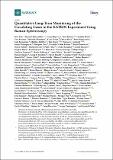Quantitative long-term monitoring of the circulating gases in the KATRIN experiment using Raman spectroscopy
Author(s)
Formaggio, Joseph A; Xu, Weiran
Downloadsensors-20-04827-v2.pdf (6.479Mb)
Publisher with Creative Commons License
Publisher with Creative Commons License
Creative Commons Attribution
Terms of use
Metadata
Show full item recordAbstract
The Karlsruhe Tritium Neutrino (KATRIN) experiment aims at measuring the effective electron neutrino mass with a sensitivity of 0.2 eV/c[superscript 2], i.e., improving on previous measurements by an order of magnitude. Neutrino mass data taking with KATRIN commenced in early 2019, and after only a few weeks of data recording, analysis of these data showed the success of KATRIN, improving on the known neutrino mass limit by a factor of about two. This success very much could be ascribed to the fact that most of the system components met, or even surpassed, the required specifications during long-term operation. Here, we report on the performance of the laser Raman (LARA) monitoring system which provides continuous high-precision information on the gas composition injected into the experiment's windowless gaseous tritium source (WGTS), specifically on its isotopic purity of tritium--one of the key parameters required in the derivation of the electron neutrino mass. The concentrations c[subscript x] for all six hydrogen isotopologues were monitored simultaneously, with a measurement precision for individual components of the order 10[superscript -3] or better throughout the complete KATRIN data taking campaigns to date. From these, the tritium purity, ε[subscript T] is derived with precision of 10[superscript -3] and trueness of 3 x 10[superscript -3], being within and surpassing the actual requirements for KATRIN, respectively.
Date issued
2020-08Department
Massachusetts Institute of Technology. Laboratory for Nuclear ScienceJournal
Sensors
Publisher
Multidisciplinary Digital Publishing Institute
Citation
Aker, Max et al. "Quantitative long-term monitoring of the circulating gases in the KATRIN experiment using Raman spectroscopy." Sensors 20, 17 (August 2020): 4827 ©2020 Author(s)
Version: Final published version
ISSN
1424-8220
Keywords
United States Department of Energy (grants DE-FG02-97ER41020, DE-FG02-94ER40818, DE-SC0004036, DE-FG02-97ER41033, DE-FG02-97ER41041, DE-AC02-05CH11231, DE-SC0011091, and DE-SC0019304)